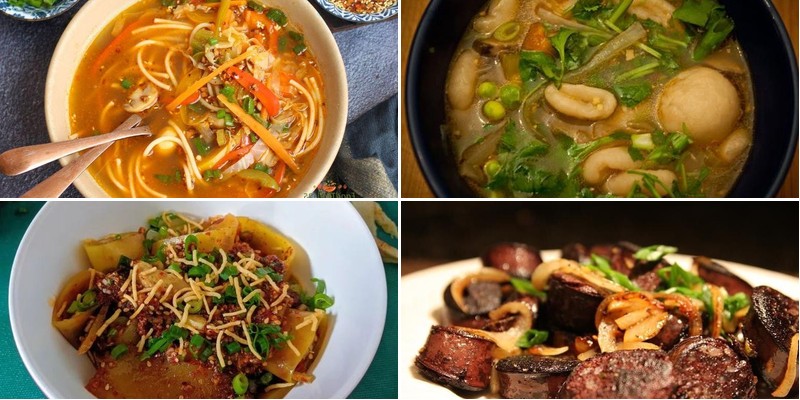A journey to the rooftop of the world awaits your kitchen! Tibetan cuisine is a hidden gem of bold, warming flavors and nourishing comfort food, perfect for adventurous home cooks. From hearty stews to fluffy breads, these 31 authentic recipes will transport your taste buds to the Himalayas. Ready to explore? Let’s dive into these delicious dishes you can easily recreate at home.
Mouthwatering Momos with Spicy Tomato Chutney

Kindly imagine delicate, steamed parcels that unfold with aromatic warmth, these momos represent the perfect balance of tender dough and savory filling, elevated by a vibrant tomato chutney that dances on the palate. Crafting these dumplings transforms an ordinary evening into something truly special, where each bite tells a story of careful preparation and bold flavors. They’re a celebration of texture and spice, inviting you to savor every moment from kitchen to table.
Ingredients
– 2 cups all-purpose flour (I always use unbleached for that perfect, soft texture)
– 1/2 cup warm water (around 110°F—just warm to the touch)
– 1/2 lb ground chicken (thawed completely for even mixing)
– 1/4 cup finely chopped cabbage (I prefer fresh green cabbage for crunch)
– 2 tbsp minced garlic (freshly minced releases the best aroma)
– 1 tbsp vegetable oil (a neutral oil keeps flavors clean)
– 1 tsp soy sauce (low-sodium is my go-to for balance)
– 1/2 tsp black pepper (freshly ground adds a subtle kick)
– 1/4 tsp salt (fine sea salt dissolves evenly)
– 2 large tomatoes, chopped (ripe, juicy ones make the chutney sing)
– 1 small onion, diced (yellow onions bring a sweet depth)
– 1-2 green chilies, sliced (adjust for heat—I use two for a bold spice)
– 1 tbsp lemon juice (freshly squeezed brightens everything)
Instructions
1. In a medium bowl, combine 2 cups all-purpose flour and 1/2 cup warm water, mixing with your hands until a shaggy dough forms. Tip: If the dough feels dry, add water 1 tbsp at a time to avoid stickiness.
2. Knead the dough on a floured surface for 5-7 minutes until smooth and elastic, then cover with a damp cloth and let it rest for 30 minutes to relax the gluten.
3. In another bowl, mix 1/2 lb ground chicken, 1/4 cup chopped cabbage, 2 tbsp minced garlic, 1 tbsp vegetable oil, 1 tsp soy sauce, 1/2 tsp black pepper, and 1/4 tsp salt until well combined. Tip: Refrigerate the filling for 15 minutes to firm it up for easier shaping.
4. Divide the rested dough into 20 equal portions and roll each into a thin, 3-inch circle on a floured surface.
5. Place 1 tbsp of the chicken filling in the center of each dough circle, then pleat and seal the edges firmly to form half-moon shapes. Tip: Moisten the edges with water to ensure a tight seal that prevents bursting during steaming.
6. Arrange the momos in a single layer in a steamer basket lined with parchment paper, leaving space between them to avoid sticking.
7. Steam the momos over boiling water for 12-15 minutes until the dough turns translucent and the filling is fully cooked through.
8. For the chutney, sauté 1 diced onion and 1-2 sliced green chilies in 1 tbsp vegetable oil over medium heat for 4-5 minutes until softened.
9. Add 2 chopped tomatoes and cook for 8-10 minutes, stirring occasionally, until they break down into a thick sauce.
10. Stir in 1 tbsp lemon juice, then blend the mixture until smooth using an immersion blender or food processor.
11. Serve the momos hot with the spicy tomato chutney on the side. Revel in the tender, juicy texture of the momos, which pairs beautifully with the chutney’s fiery tang. For a creative twist, garnish with fresh cilantro or serve alongside a crisp salad to balance the richness.
Flavorful Thukpa Noodle Soup
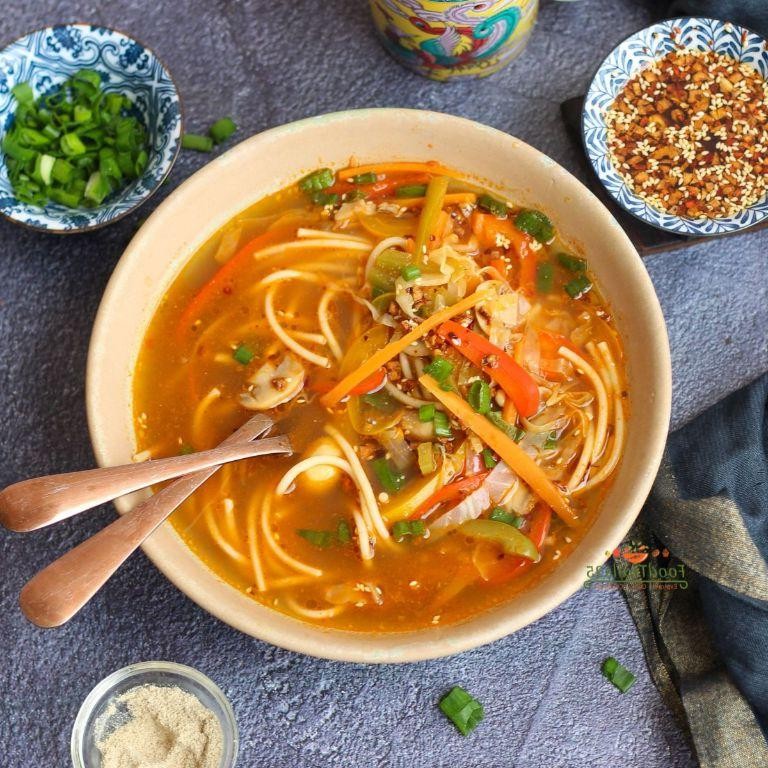
Radiant with the warmth of Himalayan tradition, this soul-soothing thukpa brings together delicate noodles and aromatic spices in a broth that comforts from the first spoonful. Imagine tender wheat strands swimming in a golden liquid infused with ginger, garlic, and earthy turmeric, each bowl offering both nourishment and vibrant flavor. It’s the perfect balance of hearty satisfaction and delicate spice that makes this dish truly unforgettable.
Ingredients
– 8 cups chicken broth (I prefer low-sodium to better control seasoning)
– 1 lb boneless chicken thighs, cut into 1-inch pieces (thighs stay wonderfully juicy)
– 8 oz wheat noodles (the thicker, chewier kind hold up best)
– 1 large yellow onion, thinly sliced
– 3 cloves garlic, minced (freshly minced makes all the difference)
– 1-inch piece ginger, grated
– 2 tbsp vegetable oil
– 1 tsp turmeric powder
– 1 tsp cumin seeds
– ½ tsp red chili flakes (adjust to your heat preference)
– 4 cups fresh spinach leaves
– 2 tbsp soy sauce
– 1 tbsp lime juice (freshly squeezed brightens everything)
– ¼ cup chopped cilantro
– 2 green onions, sliced
Instructions
1. Heat vegetable oil in a large pot over medium heat until shimmering.
2. Add cumin seeds and cook for 30 seconds until fragrant and slightly darkened.
3. Add sliced onion and cook for 5 minutes, stirring occasionally, until softened and translucent.
4. Stir in minced garlic and grated ginger, cooking for 1 minute until aromatic but not browned.
5. Add chicken pieces and cook for 4 minutes, turning occasionally, until exterior is white.
6. Sprinkle turmeric and red chili flakes over chicken, stirring to coat evenly.
7. Pour in chicken broth and bring to a boil over high heat.
8. Reduce heat to maintain a gentle simmer and cook for 15 minutes until chicken is fully cooked.
9. Meanwhile, cook wheat noodles according to package directions until al dente, then drain. (Tip: Rinse briefly with cool water to prevent sticking.)
10. Add soy sauce and lime juice to the simmering broth.
11. Stir in fresh spinach leaves and cook for 2 minutes until just wilted.
12. Divide cooked noodles among serving bowls.
13. Ladle hot soup over noodles, ensuring each bowl gets plenty of chicken and vegetables.
14. Garnish with chopped cilantro and sliced green onions. (Tip: Let guests add extra lime wedges for personalized brightness.)
Glistening with vibrant greens and golden broth, this thukpa delivers satisfying chew from the wheat noodles against the tender chicken and wilted spinach. The broth carries layers of warmth from ginger and cumin, balanced by the fresh zing of lime and cilantro. For an extra dimension, top with a soft-boiled egg or serve with chili oil for those who crave additional heat.
Rich and Hearty Tibetan Butter Tea

Yet there exists a beverage that transcends mere refreshment, a centuries-old Tibetan tradition that warms both body and spirit with its profound richness. This butter tea, known as po cha, combines robust black tea with the creamy intensity of yak butter and a whisper of salt to create something truly extraordinary. Each velvety sip offers comfort and sustenance, perfect for chilly mornings or contemplative afternoons.
Ingredients
- 4 cups water (I find filtered water makes the cleanest-tasting brew)
- 2 tablespoons loose-leaf Assam black tea (this bold variety stands up beautifully to the butter)
- 1/2 cup unsalted butter, preferably cultured or European-style for deeper flavor
- 1/4 teaspoon fine sea salt (I prefer the delicate crystals over coarse here)
- 1/4 cup half-and-half (though traditional yak butter is ideal, this creates a wonderfully accessible creaminess)
Instructions
- Bring 4 cups of water to a rolling boil in a medium saucepan over high heat.
- Add 2 tablespoons of loose-leaf Assam black tea directly to the boiling water.
- Reduce heat to medium-low and simmer the tea for 5 minutes exactly, allowing the leaves to fully unfurl and release their robust character.
- Strain the brewed tea through a fine-mesh sieve into a heatproof pitcher, pressing gently on the leaves to extract every drop of flavor.
- Pour the hot tea into a blender, taking care as the liquid will be very hot.
- Add 1/2 cup unsalted butter, 1/4 teaspoon fine sea salt, and 1/4 cup half-and-half to the blender.
- Secure the blender lid tightly and cover it with a kitchen towel for safety.
- Blend on high speed for 45-60 seconds until the mixture becomes frothy and completely emulsified, creating that signature silken texture.
- Immediately pour the blended butter tea into warmed ceramic mugs to maintain its optimal drinking temperature.
For the most authentic experience, serve this butter tea in small portions throughout the day, as Tibetans traditionally do. The resulting brew possesses an extraordinary velvety texture that coats the palate, with the bold tea notes perfectly balanced by the rich, savory butter and subtle saltiness. Consider enjoying it alongside toasted barley flour cakes or simply as a meditative morning ritual that nourishes from within.
Exquisite Sha Phaley (Tibetan Meat Pie)

Kindly imagine the perfect savory pastry—crisp, golden-brown exterior giving way to a richly spiced, tender filling that whispers of Himalayan traditions. Exquisite Sha Phaley, the Tibetan meat pie, transforms humble ingredients into handheld culinary art, marrying flaky dough with deeply seasoned ground meat in a symphony of textures. These crescent-shaped delights offer both comfort and sophistication, perfect for elevating any gathering or quiet evening meal.
Ingredients
– 2 cups all-purpose flour, plus extra for dusting—I find King Arthur brand gives the ideal protein content for sturdy yet tender dough
– 1/2 cup warm water (110°F), tested with a kitchen thermometer for perfect yeast activation if using leavened variations
– 1/2 lb ground beef (80/20 blend), chilled—the slight fat content ensures juicy filling without greasiness
– 1 medium yellow onion, finely diced; I prefer sweet Vidalias for their mellow caramelization
– 2 cloves garlic, minced—freshly crushed releases more aromatic oils than pre-minced
– 1 tsp ground cumin, toasted lightly in a dry pan first to awaken its earthy notes
– 1/2 tsp Sichuan peppercorns, freshly ground for that tingling, citrusy warmth unique to Tibetan cuisine
– 2 tbsp vegetable oil, divided; avocado oil works beautifully for its high smoke point
– 1/2 tsp salt, fine sea salt disperses evenly through both dough and filling
Instructions
1. Combine 2 cups flour and 1/2 tsp salt in a large bowl, whisking to distribute evenly.
2. Gradually pour 1/2 cup warm water into flour mixture while stirring with a fork until shaggy dough forms.
3. Knead dough on lightly floured surface for 5 minutes until smooth and elastic, then cover with damp cloth and rest 30 minutes.
4. Heat 1 tbsp vegetable oil in skillet over medium heat until shimmering but not smoking.
5. Sauté diced onion for 4 minutes until translucent, stirring frequently to prevent burning.
6. Add minced garlic and cook 1 minute until fragrant, being careful not to brown it.
7. Incorporate ground beef, breaking it up with wooden spoon, and cook 6 minutes until no pink remains.
8. Stir in toasted cumin and ground Sichuan peppercorns, cooking 1 minute to bloom spices.
9. Remove filling from heat and cool completely to room temperature—this prevents dough from steaming and becoming gummy.
10. Divide rested dough into 8 equal portions, rolling each into 5-inch circles on floured surface.
11. Place 2 tbsp cooled meat mixture in center of each circle, leaving 1/2-inch border.
12. Fold dough over filling to form half-moons, pressing edges firmly to seal—try the fork-crimp method for decorative, secure edges.
13. Heat remaining 1 tbsp oil in clean skillet over medium-low heat until it lightly ripples.
14. Pan-fry pies in batches for 4 minutes per side until deep golden brown, adjusting heat if browning too quickly.
15. Transfer to paper towel-lined plate to drain excess oil before serving.
Yield these flaky masterpieces still warm, where the audible crackle of the crust gives way to aromatic, spiced meat. The Sichuan peppercorns lend a subtle tingling warmth that plays beautifully against the savory cumin and sweet onions. For an authentic touch, serve with a simple chili garlic sauce or cool cucumber salad to balance the richness.
Traditional Tsampa Porridge

Tibetan cuisine offers some of the world’s most nourishing comfort foods, and traditional tsampa porridge stands out as a beautifully simple yet deeply satisfying dish that has sustained Himalayan communities for centuries. This roasted barley porridge delivers an earthy, nutty flavor profile that feels both ancient and wonderfully contemporary, perfect for chilly mornings or whenever you crave wholesome warmth. Vividly golden and comforting, this porridge achieves a perfect balance between creamy texture and satisfying graininess that makes each spoonful a delightful experience.
Ingredients
– 1 cup roasted barley flour (tsampa) – I prefer stone-ground for its rustic texture and deeper nutty notes
– 3 cups water – filtered water really lets the barley’s natural flavors shine through
– ½ teaspoon fine sea salt – this enhances the barley’s inherent sweetness without overwhelming it
– 2 tablespoons unsalted butter – I always use high-quality European-style butter for its rich, creamy finish
– ¼ cup whole milk – room temperature works best to prevent temperature shock when adding
Instructions
1. Measure 3 cups of filtered water into a medium saucepan and place it over medium-high heat.
2. Bring the water to a rolling boil, which should take approximately 5-7 minutes – you’ll see large bubbles breaking the surface consistently.
3. Reduce the heat to low immediately once boiling to prevent scorching when adding the barley flour.
4. Gradually sprinkle 1 cup of roasted barley flour into the simmering water while whisking constantly to prevent lumps from forming.
5. Continue whisking for 2 minutes until the mixture thickens slightly and no dry flour remains visible.
6. Add ½ teaspoon of fine sea salt and stir thoroughly to distribute evenly throughout the porridge.
7. Cover the saucepan with a tight-fitting lid and simmer on low heat for 8 minutes – this allows the barley to fully hydrate and develop its flavor.
8. Remove the lid and check the consistency – the porridge should coat the back of a spoon thickly but still flow slowly.
9. Stir in 2 tablespoons of unsalted butter until completely melted and incorporated, which adds richness and helps create a silky texture.
10. Pour in ¼ cup of room temperature whole milk and stir gently for 1 minute until the porridge becomes creamy and smooth.
11. Remove from heat and let rest for 2 minutes before serving to allow the flavors to meld perfectly. The finished porridge boasts a wonderfully complex texture that’s simultaneously creamy and pleasantly grainy, with the roasted barley delivering warm, nutty notes that deepen with each bite. For an elegant presentation, I love serving it in handmade ceramic bowls topped with a drizzle of honey and toasted walnuts, creating beautiful contrast between the golden porridge and crunchy toppings.
Savoury Laphing with Chilli Oil
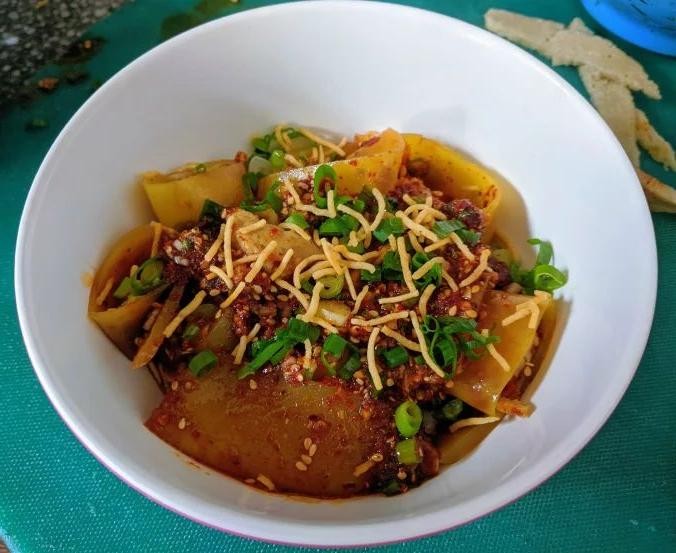
Masterfully balancing delicate textures with bold, fiery flavors, Savoury Laphing offers a captivating culinary experience that transforms simple ingredients into an extraordinary dish. This Tibetan street food classic, with its translucent wheat starch sheets and aromatic chili oil, delivers both visual elegance and profound depth of flavor in every bite. The interplay between the cool, chewy noodles and the vibrant, spicy sauce creates a symphony of sensations that will transport your palate to distant mountain regions.
Ingredients
- 1 cup wheat starch – I find this creates the perfect translucent texture for authentic laphing
- 4 cups cold water – chilled water helps achieve that signature chewy bite
- 2 tablespoons soy sauce – I prefer low-sodium to better control the salt level
- 3 tablespoons homemade chili oil – my secret is using Szechuan peppercorns for that numbing heat
- 1 teaspoon minced garlic – fresh is essential for that bright, aromatic punch
- 1 tablespoon rice vinegar – this adds the perfect tangy counterpoint to the spice
- 1/2 teaspoon sesame oil – just a drizzle enhances the overall aroma beautifully
- 2 green onions, finely chopped – I like to include both white and green parts for complexity
Instructions
- Combine 1 cup wheat starch with 4 cups cold water in a large mixing bowl, whisking continuously for 2 minutes until no lumps remain.
- Pour the starch mixture through a fine-mesh sieve into a clean saucepan to remove any remaining clumps.
- Heat the strained mixture over medium-low heat, stirring constantly with a wooden spoon for 8-10 minutes until it thickens to a pudding-like consistency.
- Lightly oil an 8×8 inch baking pan and pour the hot starch mixture into it, spreading evenly with an offset spatula.
- Steam the pan in a bamboo steamer over boiling water for 15 minutes until the sheet becomes translucent and firm to the touch.
- Transfer the steamed sheet to an ice water bath for 5 minutes to stop the cooking process and enhance chewiness.
- Remove the cooled sheet from water and pat dry with paper towels, then roll it tightly into a cylinder shape.
- Slice the rolled sheet crosswise into 1/2-inch wide ribbons using a sharp knife for clean cuts.
- Arrange the laphing ribbons on a serving plate in a circular pattern for visual appeal.
- Whisk together 2 tablespoons soy sauce, 3 tablespoons chili oil, 1 teaspoon minced garlic, 1 tablespoon rice vinegar, and 1/2 teaspoon sesame oil in a small bowl.
- Drizzle the sauce mixture evenly over the arranged laphing ribbons, ensuring each piece gets coated.
- Sprinkle 2 chopped green onions over the dressed laphing as the final garnish.
Perfectly chewy with a satisfying gelatinous texture, these translucent noodles provide the ideal canvas for the complex chili oil sauce that delivers both heat and numbing sensation. The cool temperature of the laphing creates a refreshing contrast against the warm, spicy dressing that tingles across the palate. Present this stunning dish as an appetizer on individual slate plates or family-style on a large ceramic platter surrounded by fresh herb sprigs for an impressive visual display.
Classic Tingmo (Steamed Tibetan Bread)
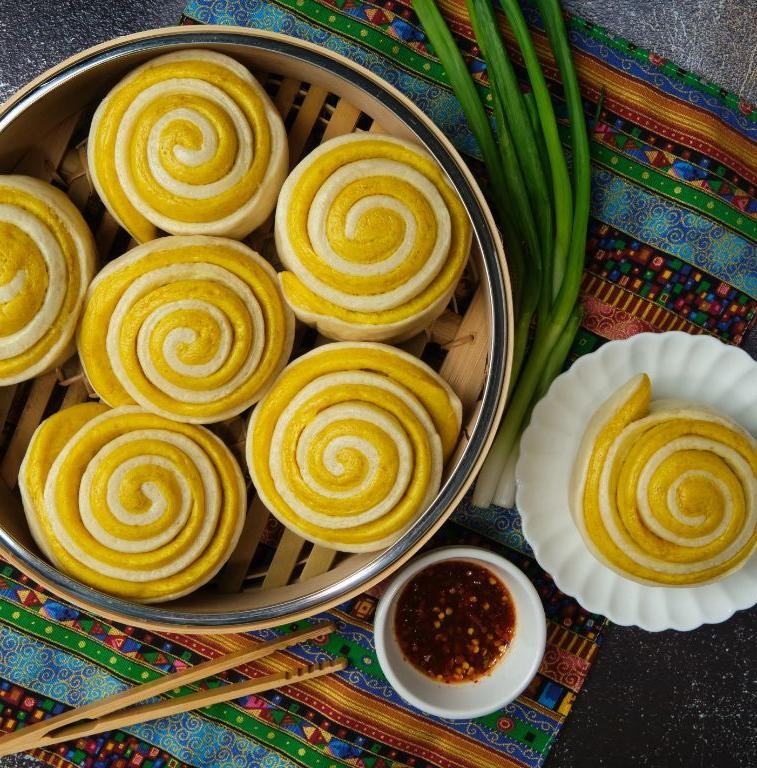
Venturing beyond the usual bread basket, Classic Tingmo offers a cloud-like steamed bread that carries the subtle aromas of Tibetan highlands in each delicate, pull-apart layer. This steamed delight transforms simple pantry ingredients into pillowy rounds perfect for soaking up sauces or enjoying with morning tea. Its gentle fermentation and steaming process creates a texture that’s simultaneously airy and satisfyingly substantial.
Ingredients
– 3 cups all-purpose flour (I prefer King Arthur for its consistent protein content)
– 1 cup warm water at 110°F (test on your wrist—it should feel comfortably warm, not hot)
– 2 teaspoons active dry yeast (I always check the expiration date for maximum rise)
– 1 tablespoon granulated sugar (this helps activate the yeast beautifully)
– 1 teaspoon fine sea salt (I find it dissolves more evenly than kosher salt here)
– 1 tablespoon neutral oil like avocado or vegetable (a light coating prevents sticking)
Instructions
1. Combine warm water, yeast, and sugar in a small bowl, then let it sit for exactly 5 minutes until foamy and fragrant.
2. Whisk flour and salt together in a large mixing bowl, creating a well in the center for the liquid ingredients.
3. Pour the activated yeast mixture and oil into the flour well, then stir with a wooden spoon until a shaggy dough forms.
4. Turn the dough onto a lightly floured surface and knead for 8-10 minutes until smooth and elastic, using the heel of your hand to push away from you then folding back.
5. Place the kneaded dough in a lightly oiled bowl, turning once to coat, then cover with a damp kitchen towel.
6. Let the dough rise in a warm, draft-free area for 1 hour or until doubled in size—I often use my turned-off oven with the light on.
7. Punch down the risen dough to release air bubbles, then divide into 8 equal portions using a bench scraper.
8. Roll each portion into smooth balls, then use a rolling pin to flatten into 4-inch circles about ½-inch thick.
9. Place each circle on a small square of parchment paper to prevent sticking during steaming.
10. Cover the shaped tingmo with the damp towel and let rest for 20 minutes until slightly puffed.
11. Bring 2 inches of water to a rolling boil in a steamer pot or wok with a steaming rack.
12. Arrange tingmo in the steamer, leaving 1 inch between each for expansion, then cover tightly.
13. Steam over medium-high heat for 15 minutes without peeking—this ensures proper rise and texture.
14. Turn off heat and let tingmo rest in the steamer for 5 minutes before removing the lid to prevent shrinkage.
Keeping these cloud-like breads warm in a basket, their soft, slightly sweet flavor and remarkable pull-apart texture make them perfect for dipping into curries or serving alongside morning tea. The delicate layers created through steaming rather than baking yield a uniquely tender crumb that stays moist for hours, making them ideal for soaking up rich sauces without becoming soggy.
Wholesome Thenthuk Soup
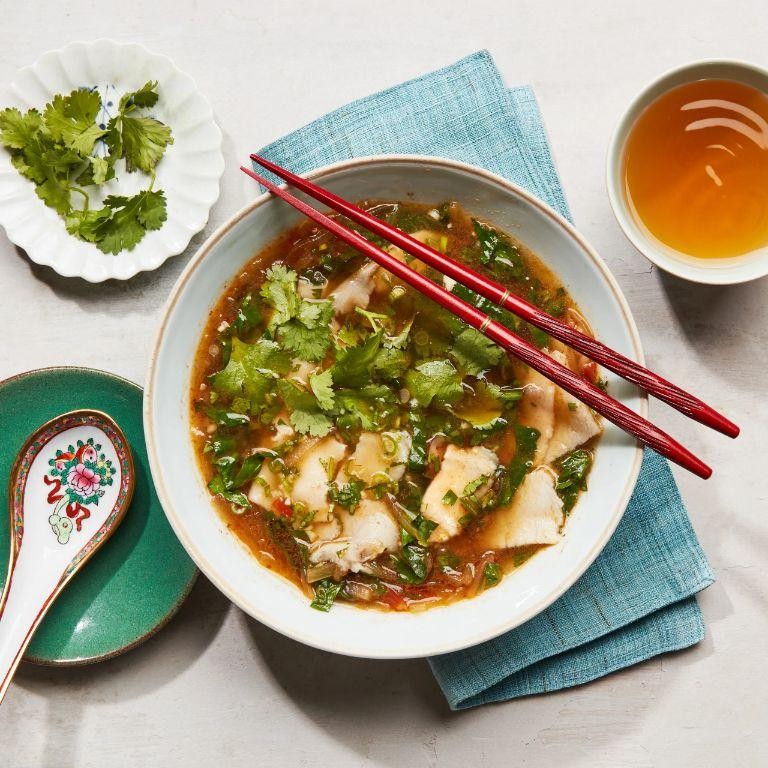
Kneaded with tradition and warmth, this Tibetan-inspired Thenthuk soup brings comfort in every spoonful, featuring hand-pulled noodles that cradle tender vegetables in a deeply savory broth. Perfect for chilly evenings, it transforms simple ingredients into a nourishing meal that feels both exotic and familiar. Each bowl offers a glimpse into Himalayan culinary heritage while satisfying modern cravings for wholesome, homemade goodness.
Ingredients
– 1 lb boneless chicken thighs, cut into ½-inch pieces (I prefer thighs for their richer flavor)
– 2 cups all-purpose flour, plus extra for dusting
– 1 large egg, at room temperature for easier mixing
– 6 cups chicken broth, preferably low-sodium to control seasoning
– 2 medium carrots, peeled and sliced into ¼-inch rounds
– 1 cup fresh spinach leaves, roughly chopped
– 3 cloves garlic, minced (freshly minced releases the best aroma)
– 1 tbsp vegetable oil
– 1 tsp salt
– ½ tsp black pepper
Instructions
1. Combine 2 cups all-purpose flour, 1 large egg, and ½ cup water in a mixing bowl until a shaggy dough forms.
2. Knead the dough on a floured surface for 8 minutes until smooth and elastic, then cover with a damp cloth and rest for 30 minutes at room temperature.
3. Heat 1 tbsp vegetable oil in a large pot over medium heat until shimmering, about 2 minutes.
4. Add 1 lb boneless chicken thighs and cook for 6–7 minutes, turning occasionally, until golden brown on all sides.
5. Stir in 3 cloves minced garlic and cook for 1 minute until fragrant but not browned.
6. Pour in 6 cups chicken broth, 1 tsp salt, and ½ tsp black pepper, then bring to a boil over high heat.
7. Reduce heat to medium-low, cover, and simmer for 15 minutes to infuse flavors.
8. Roll the rested dough into a ¼-inch thick rectangle on a floured surface.
9. Cut the dough into 2-inch wide strips, then gently stretch each strip lengthwise until ¼-inch thick.
10. Add 2 medium sliced carrots to the simmering broth and cook for 5 minutes until slightly tender.
11. Drop the stretched dough strips into the broth one at a time, stirring gently to prevent sticking.
12. Simmer uncovered for 8 minutes until noodles are cooked through and float to the surface.
13. Stir in 1 cup fresh spinach leaves and cook for 1 minute until just wilted.
Buttery soft noodles meld with the savory broth, creating a comforting chew alongside tender chicken and vibrant vegetables. For a creative twist, top with a drizzle of chili oil or serve with steamed dumplings to elevate this humble soup into a festive meal.
Succulent Shapta Stir-Fried Beef

Zestfully capturing the essence of Central Asian cuisine, this Shapta stir-fry transforms humble beef into a symphony of tender textures and aromatic spices. Velvety slices of meat dance with crisp vegetables in a sauce that balances heat, sweetness, and umami depth, creating a dish that feels both exotic and comforting.
Ingredients
- 1 pound beef sirloin, sliced thinly against the grain—this ensures maximum tenderness
- 2 tablespoons vegetable oil, my go-to for high-heat cooking
- 1 large yellow onion, thinly sliced—I love the sweet caramelization it brings
- 1 red bell pepper, julienned for vibrant color and crunch
- 3 cloves garlic, minced finely to distribute flavor evenly
- 1 tablespoon freshly grated ginger, which I find more aromatic than powdered
- 2 tablespoons soy sauce, preferably low-sodium to control saltiness
- 1 tablespoon rice vinegar, adding a subtle tang that brightens the dish
- 1 teaspoon cornstarch, my secret for creating a glossy, clingy sauce
- 1/2 teaspoon red pepper flakes, adjustable based on your heat preference
- 1/4 cup beef broth, which I keep homemade in the freezer for moments like this
Instructions
- Place the thinly sliced beef sirloin in a medium bowl and toss with 1 tablespoon soy sauce until evenly coated.
- Heat 2 tablespoons vegetable oil in a large wok or skillet over high heat until it shimmers, about 1 minute.
- Add the beef to the hot oil in a single layer and cook undisturbed for 90 seconds to develop a golden sear.
- Flip the beef slices and cook for another 60 seconds until browned but still pink inside, then transfer to a clean plate.
- Reduce heat to medium-high and add the sliced onion to the same skillet, cooking for 3 minutes until translucent.
- Stir in the julienned red bell pepper and cook for 2 more minutes until slightly softened.
- Add the minced garlic and grated ginger, stirring constantly for 45 seconds until fragrant but not browned.
- In a small bowl, whisk together the remaining 1 tablespoon soy sauce, 1 tablespoon rice vinegar, 1 teaspoon cornstarch, 1/2 teaspoon red pepper flakes, and 1/4 cup beef broth until smooth.
- Pour the sauce mixture into the skillet and bring to a simmer, stirring until it thickens noticeably, about 1 minute.
- Return the cooked beef and any accumulated juices to the skillet, tossing gently to coat everything in the glossy sauce.
- Cook for exactly 30 seconds more to warm the beef through without overcooking it.
Velvety beef slices melt against the crisp-tender vegetables, while the glossy sauce delivers a perfect balance of savory soy, bright vinegar, and gentle heat. Serve this shapta immediately over steamed jasmine rice, or for a low-carb option, spoon it into crisp lettuce cups—the contrast of temperatures and textures makes each bite unforgettable.
Authentic Tibetan Chicken Curry

Aromatic spices and tender chicken come together in this exquisite Tibetan curry that transports your senses to the Himalayan foothills. As autumn settles in, this warming dish offers both comfort and adventure with its complex layers of flavor and fragrant steam that fills the kitchen with memories of distant lands. Each spoonful reveals the careful balance of traditional Tibetan cooking techniques and accessible ingredients.
Ingredients
– 1.5 lbs boneless chicken thighs, cut into 1-inch pieces (I prefer thighs for their richer flavor and tenderness)
– 2 tbsp vegetable oil (use a neutral oil to let the spices shine)
– 1 large yellow onion, finely diced (take your time here—properly caramelized onions are key)
– 4 garlic cloves, minced (fresh garlic makes all the difference)
– 1 tbsp freshly grated ginger (I keep mine frozen for easy grating)
– 2 tsp ground cumin (toast whole seeds and grind them yourself for maximum aroma)
– 1.5 tsp turmeric powder (this golden spice adds both color and earthy notes)
– 1 tsp paprika (I use sweet paprika for its vibrant red hue)
– 1/2 tsp cayenne pepper (adjust this based on your heat preference)
– 1 cup coconut milk (full-fat gives the creamiest texture)
– 1 cup chicken broth (homemade if you have it, but good quality store-bought works)
– 1 tsp salt (I use fine sea salt for even distribution)
– 1/4 cup chopped fresh cilantro (reserve some for garnish)
Instructions
1. Heat 2 tbsp vegetable oil in a large Dutch oven over medium heat until shimmering, about 2 minutes.
2. Add 1 large finely diced yellow onion and cook, stirring frequently, until golden brown and caramelized, approximately 8-10 minutes. (Tip: Don’t rush this step—properly caramelized onions create the flavor foundation.)
3. Add 4 minced garlic cloves and 1 tbsp freshly grated ginger, cooking for 1 minute until fragrant but not browned.
4. Add 2 tsp ground cumin, 1.5 tsp turmeric, 1 tsp paprika, and 1/2 tsp cayenne pepper, toasting the spices for 30 seconds while stirring constantly to prevent burning.
5. Add 1.5 lbs chicken pieces in a single layer, searing for 3 minutes per side until lightly browned but not cooked through.
6. Pour in 1 cup coconut milk and 1 cup chicken broth, scraping the bottom of the pot to incorporate all the browned bits.
7. Bring the mixture to a gentle simmer, then reduce heat to low, cover, and cook for 25 minutes until chicken is tender and cooked through. (Tip: Maintain a gentle simmer—boiling will toughen the chicken.)
8. Stir in 1 tsp salt and 1/4 cup chopped cilantro, then simmer uncovered for 5 minutes to allow flavors to meld. (Tip: Taste and adjust seasoning now, as the flavors will concentrate slightly.)
9. Remove from heat and let rest for 5 minutes before serving to allow the sauce to thicken slightly.
Final thoughts reveal a curry with remarkably tender chicken that falls apart at the slightest pressure, swimming in a golden-hued sauce that’s simultaneously rich from coconut milk and bright from fresh herbs. For an authentic Tibetan experience, serve this curry over steamed jasmine rice with a side of simple cucumber salad to cut through the richness, creating a meal that feels both exotic and comforting.
Nutritious Dre-si (Sweetened Rice with Dry Fruits)

Elegant yet comforting, this Nutritious Dre-si transforms humble rice into a celebration-worthy dessert that balances natural sweetness with satisfying texture. Perfect for holiday gatherings or a special weekend treat, this sweetened rice dish brings warmth and sophistication to any table. Each spoonful offers a delightful contrast between creamy rice and chewy dried fruits, creating a dessert that feels both indulgent and nourishing.
Ingredients
– 1 cup short-grain white rice, which I find creates the perfect creamy texture
– 2 cups whole milk, preferably organic for richer flavor
– 1/2 cup granulated sugar, though I sometimes reduce this slightly for a less sweet version
– 1/4 cup golden raisins, plumped in warm water for extra juiciness
– 1/4 cup chopped dried apricots, my favorite for their bright tang
– 2 tablespoons unsalted butter, always at room temperature for easier melting
– 1/2 teaspoon ground cardamom, freshly ground if possible for maximum aroma
– 1/4 cup sliced almonds, lightly toasted for better crunch
– Pinch of fine sea salt, which I believe enhances all the flavors beautifully
Instructions
1. Rinse 1 cup short-grain white rice under cold running water until the water runs clear, about 2 minutes, to remove excess starch.
2. Combine the rinsed rice with 2 cups whole milk in a heavy-bottomed saucepan over medium heat.
3. Bring the mixture to a gentle simmer, then immediately reduce heat to low and cover with a tight-fitting lid.
4. Cook for 15 minutes without stirring, until the rice has absorbed most of the milk but remains slightly soupy.
5. Stir in 1/2 cup granulated sugar and the pinch of fine sea salt until completely dissolved.
6. Add 1/4 cup golden raisins and 1/4 cup chopped dried apricots, distributing them evenly throughout the rice.
7. Continue cooking uncovered over low heat for 8-10 minutes, stirring occasionally, until the mixture thickens to a pudding-like consistency.
8. Remove from heat and stir in 2 tablespoons room temperature butter until fully incorporated and glossy.
9. Fold in 1/2 teaspoon ground cardamom and 1/4 cup sliced almonds, reserving a few almonds for garnish.
10. Let the dre-si rest for 5 minutes off the heat to allow flavors to meld before serving.
Perfectly balanced between creamy and textured, this dre-si offers subtle floral notes from the cardamom that complement the natural sweetness of the dried fruits. The toasted almonds provide a satisfying crunch against the tender rice, making each bite a delightful sensory experience. Serve it warm in elegant glass bowls, perhaps with a drizzle of honey or a sprinkle of cinnamon for those who enjoy extra warmth.
Tibetan Gyuma Sausages
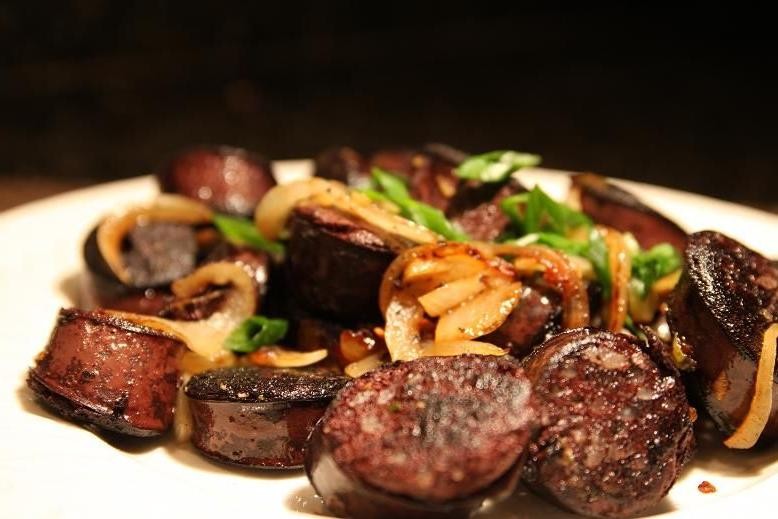
Tibetan gyuma sausages offer a captivating journey into Himalayan cuisine, where robust spices and tender textures create an unforgettable culinary experience. These aromatic links combine the warmth of traditional Tibetan flavors with an approachable preparation perfect for adventurous home cooks seeking global inspiration.
Ingredients
– 1 pound ground pork shoulder (the higher fat content creates juicier sausages)
– 2 tablespoons soy sauce (I prefer low-sodium to control saltiness)
– 1 tablespoon minced garlic (freshly minced releases the most flavor)
– 1 teaspoon ground Sichuan peppercorns (toasted first for maximum aromatic punch)
– ½ teaspoon cayenne pepper (adjust based on your heat preference)
– ¼ cup ice water (crucial for keeping the mixture cool during mixing)
– 1 tablespoon vegetable oil (my go-to for high-heat searing)
– Natural sausage casings, soaked in cold water (they should feel pliable and odorless)
Instructions
1. Combine 1 pound ground pork shoulder, 2 tablespoons soy sauce, 1 tablespoon minced garlic, 1 teaspoon ground Sichuan peppercorns, and ½ teaspoon cayenne pepper in a large bowl.
2. Gradually incorporate ¼ cup ice water while mixing with your hands for exactly 3 minutes until the mixture becomes sticky and emulsified.
3. Chill the sausage mixture in the refrigerator for 30 minutes to allow flavors to meld and fat to firm up.
4. Rinse natural sausage casings under cold running water, then slide them onto a sausage stuffer nozzle, leaving 4 inches hanging loose.
5. Fill the casings with the chilled mixture, twisting links every 5 inches while applying steady pressure.
6. Prick each sausage 3-4 times with a sterilized needle to prevent bursting during cooking.
7. Heat 1 tablespoon vegetable oil in a cast-iron skillet over medium heat until it shimmers, about 2 minutes.
8. Arrange sausages in a single layer without crowding and cook for 6 minutes until golden brown.
9. Flip sausages using tongs and cook for another 6 minutes until internal temperature reaches 160°F on an instant-read thermometer.
10. Transfer sausages to a wire rack to rest for 5 minutes before serving.
Unmistakably savory with a subtle heat that builds gradually, these gyuma sausages boast a satisfying snap when bitten into their caramelized casing. Serve them sliced over steamed rice with pickled vegetables, or tuck them into warm flatbreads with fresh herbs for a handheld feast that transports your senses straight to the Himalayan foothills.
Satisfying Guthuk (Tibetan Pasta Soup)

A comforting bowl of Guthuk, the traditional Tibetan pasta soup, offers profound warmth that transcends mere sustenance, with its handcrafted noodles and aromatic broth promising both culinary adventure and soulful nourishment. As winter’s chill settles in, this richly spiced soup becomes my kitchen sanctuary, where each ingredient tells a story of Himalayan traditions adapted for the modern American cook. The gentle simmer of spices fills the air with an invitation to slow down and savor the ritual of creating something truly special from scratch.
Ingredients
– 2 cups all-purpose flour (I always use King Arthur for its consistent quality)
– 3 large eggs, preferably at room temperature for easier dough handling
– 1 tablespoon extra virgin olive oil (my go-to for its fruity notes)
– 8 cups vegetable broth (homemade if you have it, but Pacific Foods works beautifully)
– 1 medium yellow onion, finely diced (I find sweet onions add lovely depth)
– 3 cloves garlic, minced (freshly crushed releases the most aroma)
– 1 tablespoon grated fresh ginger (frozen ginger works in a pinch)
– 2 carrots, cut into thin matchsticks
– 2 celery stalks, sliced diagonally
– 1 teaspoon ground turmeric
– 1/2 teaspoon freshly ground black pepper
– 1/4 cup chopped fresh cilantro for garnish
Instructions
1. Combine 2 cups all-purpose flour and 1/2 teaspoon salt in a large mixing bowl, creating a well in the center.
2. Crack 3 large eggs into the flour well and add 1 tablespoon extra virgin olive oil.
3. Using a fork, gradually incorporate the flour into the wet ingredients until a shaggy dough forms.
4. Knead the dough on a lightly floured surface for 8-10 minutes until smooth and elastic.
5. Cover the dough with a damp kitchen towel and let it rest for 30 minutes at room temperature.
6. Meanwhile, heat 1 tablespoon olive oil in a large Dutch oven over medium heat until shimmering.
7. Add 1 diced yellow onion and cook for 5-7 minutes until translucent and fragrant.
8. Stir in 3 minced garlic cloves and 1 tablespoon grated ginger, cooking for 1 minute until aromatic.
9. Pour in 8 cups vegetable broth and bring to a gentle boil over high heat.
10. Reduce heat to maintain a steady simmer and add 2 sliced carrots and 2 sliced celery stalks.
11. Season the broth with 1 teaspoon ground turmeric and 1/2 teaspoon black pepper.
12. Simmer the vegetables for 15 minutes until tender but still slightly crisp.
13. While the broth simmers, roll the rested dough to 1/8-inch thickness on a floured surface.
14. Cut the dough into 2-inch squares using a sharp knife or pizza cutter.
15. Drop the pasta squares into the simmering broth and cook for 4-5 minutes until they float to the surface.
16. Ladle the soup into warm bowls and garnish with 1/4 cup chopped fresh cilantro.
Zestful and deeply comforting, this Guthuk delivers tender handmade pasta swimming in golden-hued broth with vibrant vegetable confetti. The turmeric lends earthy warmth while the fresh ginger provides subtle heat that lingers pleasantly on the palate. For an elegant presentation, serve in wide, shallow bowls that showcase the beautiful pasta shapes against the colorful vegetables.
Delightful Balep Korkun (Tibetan Flatbread)

Beneath the crisp Himalayan air lies a humble culinary treasure that transforms simple pantry staples into something truly magical. Balep korkun, with its golden crust and tender interior, offers a taste of Tibetan comfort that feels both exotic and familiar, perfect for those seeking to expand their bread-making repertoire beyond the ordinary loaf. This traditional flatbread carries centuries of mountain culture in its unpretentious folds, inviting you to experience the warmth of Tibetan hospitality right in your own kitchen.
Ingredients
– 2 cups all-purpose flour (I find King Arthur brand gives the perfect protein content for this bread)
– ¾ cup warm water at 110°F (test on your wrist—it should feel comfortably warm, not hot)
– 1 teaspoon active dry yeast (I always proof mine first to ensure it’s lively)
– 1 teaspoon granulated sugar (this helps activate the yeast beautifully)
– 1 teaspoon salt (fine sea salt dissolves more evenly throughout the dough)
– 2 tablespoons vegetable oil (a neutral oil lets the flour’s natural flavor shine)
Instructions
1. Combine the warm water, yeast, and sugar in a small bowl and let it sit for 5 minutes until foamy and fragrant.
2. Tip: If your mixture doesn’t bubble within 10 minutes, your yeast may be inactive—start fresh with new yeast.
3. Whisk together the flour and salt in a large mixing bowl until thoroughly combined.
4. Create a well in the center of the flour mixture and pour in the yeast mixture and vegetable oil.
5. Mix with a wooden spoon until a shaggy dough forms, then turn out onto a lightly floured surface.
6. Knead the dough for 8-10 minutes until it becomes smooth, elastic, and springs back when lightly pressed.
7. Tip: The windowpane test works well here—stretch a small piece of dough thin enough to see light through it without tearing.
8. Place the dough in a lightly oiled bowl, cover with a damp kitchen towel, and let rise in a warm spot for 1 hour or until doubled in size.
9. Punch down the risen dough to release air bubbles and divide it into 4 equal portions.
10. Roll each portion into a ball, then use a rolling pin to flatten into 6-inch circles about ¼-inch thick.
11. Tip: For authentic texture, press your fingertips lightly into the surface to create traditional dimples.
12. Heat a dry cast-iron skillet over medium heat for 3 minutes until a drop of water sizzles immediately.
13. Cook each flatbread for 2-3 minutes per side until golden brown spots appear and the bread puffs slightly.
14. Transfer cooked breads to a wire rack to prevent steaming and maintain crispness.
Perfectly balanced between crisp exterior and soft, chewy interior, these flatbreads offer subtle wheat flavors that pair wonderfully with both savory and sweet accompaniments. Consider serving them warm with honey butter for breakfast or using them to scoop up hearty vegetable stews—their versatility makes them a welcome addition to any meal where bread is called for.
Spicy and Aromatic Khapsay (Tibetan Cookies)

Aromatic whispers of cardamom and the gentle warmth of ginger transform these traditional Tibetan cookies into something truly magical. As the crisp autumn air begins to settle, these spicy khapsay offer both comfort and adventure in every bite, bridging cultures through the universal language of buttery, spice-kissed dough. Their intricate flavors unfold slowly, much like the stories behind ancient recipes passed through generations.
Ingredients
– 2 cups all-purpose flour (I always use unbleached for a cleaner flavor)
– 1 cup granulated sugar (organic cane sugar adds a lovely depth)
– 1/2 cup unsalted butter, softened (European-style butter makes these exceptionally rich)
– 2 large eggs at room temperature (they incorporate much more smoothly this way)
– 1 teaspoon ground cardamom (freshly ground from pods if you have them)
– 1/2 teaspoon ground ginger (I prefer the sharpness of Jamaican ginger)
– 1/4 teaspoon baking powder (aluminum-free gives a purer taste)
– Pinch of salt (a flaky sea salt elevates the other flavors beautifully)
Instructions
1. Preheat your oven to 350°F and line two baking sheets with parchment paper.
2. In a medium bowl, whisk together the all-purpose flour, ground cardamom, ground ginger, baking powder, and salt until thoroughly combined.
3. Using an electric mixer on medium speed, cream the softened unsalted butter and granulated sugar together for exactly 3 minutes until pale and fluffy.
4. Add the room temperature eggs one at a time, beating for 30 seconds after each addition until fully incorporated.
5. Gradually add the flour mixture to the wet ingredients, mixing on low speed just until the dough comes together without overmixing.
6. Scoop tablespoon-sized portions of dough and roll them into smooth balls between your palms.
7. Place the dough balls 2 inches apart on the prepared baking sheets, gently flattening each to 1/2-inch thickness with your palm.
8. Bake for 12-14 minutes until the edges turn golden brown while the centers remain slightly soft.
9. Transfer the cookies to a wire rack and let them cool completely for 30 minutes before serving.
Remarkably delicate yet substantial, these khapsay achieve a perfect balance between crisp edges and tender centers that melt upon contact. Their complex spice profile deepens over time, making them even more compelling the day after baking. For an unforgettable presentation, serve them alongside cardamom-infused tea or crumble them over vanilla bean ice cream for a sophisticated dessert twist.
Conclusion
Here’s your passport to authentic Himalayan flavors! These 31 Tibetan recipes offer a delicious journey into this rich culinary tradition. We’d love to hear which dishes become your favorites—drop a comment below and share your cooking adventures on Pinterest so others can discover these amazing recipes too!
